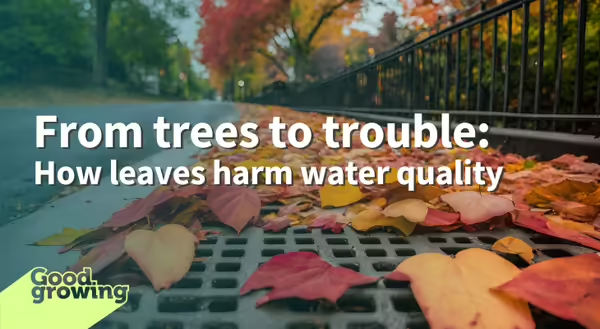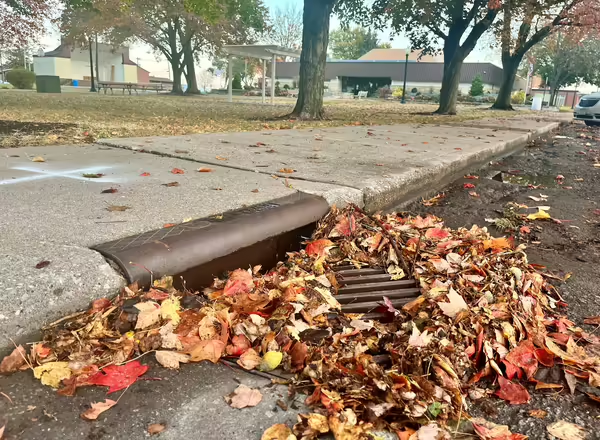
The natural process of trees shedding leaves in the fall is the most visible sign of trees preparing for winter dormancy. Shedding leaves is a tree’s way of self-preservation, reducing plant material that require resources that become scarce during the cold days and short daylight of winter.
While the rainbow of colors of fall foliage provided in the beginning of autumn is a delight, proper management of fallen leaves is essential to protect local bodies of water. Proper management of leaf debris provides an opportunity to direct the use of this nutrient-rich resource toward beneficial uses and keep it away from becoming environmentally harmful.
Decomposing plant material
In a natural woodland, tree leaves are left on the ground to decompose where they fall. Leaves that fall in the home and community landscape are rarely allowed to remain as ground cover, they are typically removed from the site. Where they end up, once removed from the landscape, determines if the decomposing leaves are adding value to the environment or diminishing ecosystems.
Leaves that find their way into storm drains, rivers, lakes, and streams decompose in these aquatic systems, releasing nutrients into the water. One of the primary nutrients made available during decomposition is phosphorous.
Phosphorus is an essential nutrient in plant development but can cause harm when in excess in aquatic environments. Plants utilize phosphorous during cell division and development, which is a key element in photosynthesis, respiration, and energy transfer. In terrestrial ecosystems, phosphorous is chemically reactive with soil and excess amounts are tied up by soil particles. In aquatic ecosystems, excess phosphorous remains available.
In water systems, high levels of available phosphorous stimulate the growth of algae, increasing the potential for algae blooms. Algae blooms deplete water oxygen levels which can be harmful and kill fish and other aquatic species. This process is known as eutrophication.
The Nutrient Loss Reduction blog and podcast Fall leaves, clean streams covers this topic in more detail.
Organic matter in water systems
In addition to high levels of phosphorus, decomposing leaves release organic matter, which can cloud the water, making it murky and reducing light penetration. Reduced levels of sunlight limit aquatic plants’ ability to complete photosynthesis processes disrupting overall ecosystem balance.
Keeping leaves out of the water systems
Once the beauty of autumn trees has passed and the leaves have fallen to the ground, it is time to take action to keep leaves out of the water systems. Homeowners and communities have options for leaf management and disposal. Below are recommendations for managing autumn leaves so local ecosystems can be protected.
- Mulch your leaves: Instead of raking and removing leaves from the landscape, use a mower to chop the leaves into small pieces. Chopped leaves can remain on a lawn without risking damage to the turf grass. Decomposing leaves add valuable nutrients to the lawn…think of it as free fertilizer.
- Compost your leaves: Leaves are an excellent addition to a compost pile. By composting leaves, they are kept out of water systems while creating nutrient-rich compost that can be added to a garden. Dried leaves are brown materials in a compost pile, be sure to add green materials such as vegetable and fruit scraps, lawn clippings, and coffee grounds.
- Bag and dispose: Many municipalities offer leaf pick-up services in the fall. Typically, communities ask that leaves are collected in biodegradable bags and placed by the curb for easy pick up. Bagging and removing leaves from the landscape prevent them from washing into sewer systems or local streams. Contact your local municipality or visit their website to confirm dates and details.
- Create leaf piles for wildlife: Consider creating small leaf piles in your landscape for wildlife to use as shelter. Animals such as insects, birds, reptiles, and small mammals will use the habitat. Locate the piles in areas of the landscape that are ‘wilder’ and incapable of washing away into water systems.
In communities that enjoy the benefits of a robust urban forest throughout the year, managing the fallen leaves is the least we can do to help protect our water systems.
Good Growing Fact of the Week: A study from Wisconsin found that nearly 60% of the annual phosphorous in urban water systems is from leaf litter. And 80% of this phosphorous can be mitigated through timely management of leaf litter.
Thank you for reading!
Sign up for our emails! Want to get notified when new Good Growing posts are available? SIGN ME UP
Give us feedback! How helpful was this information (click one): Very helpful | Somewhat helpful | Not very helpful
MEET THE AUTHOR
Emily Swihart is a horticulture educator with University of Illinois Extension, serving Henry, Mercer, Rock Island, and Stark counties since 2021. Emily provides horticulture programming with an emphasis on the home gardener, the urban forest, native plant ecosystems, and landscape design. Additional responsibilities include supporting local county Master Gardener and Master Naturalist volunteers - providing training, continuing education, advanced training, and their involvement in seasonal events and community outreach programs.
